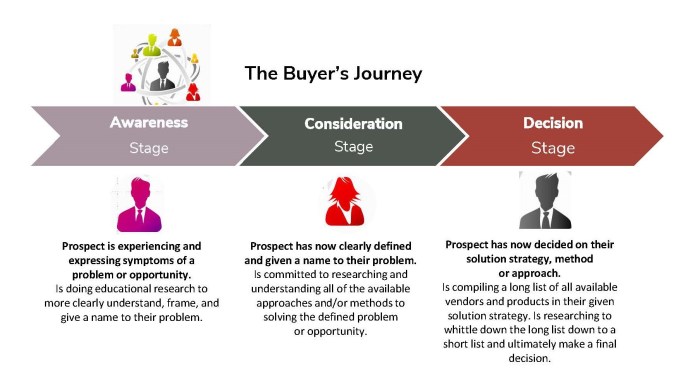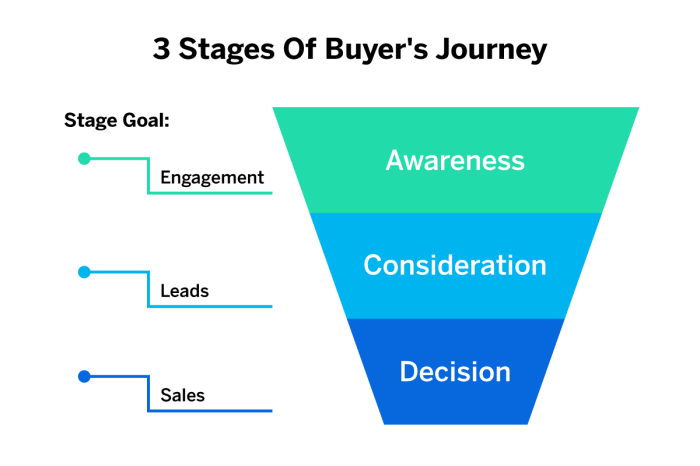Understanding the Buyer’s Journey sets the stage for exploring how consumers make purchasing decisions, shedding light on the intricate process that guides their actions at every step.
As we delve deeper into the stages, personas, content mapping, touchpoints, and engagement strategies, a comprehensive understanding of the buyer’s journey will emerge, unveiling key insights for crafting effective marketing campaigns.
The Buyer’s Journey Stages

In the buyer’s journey, there are three main stages: awareness, consideration, and decision. Each stage represents a different level of engagement and intent from the buyer.
Awareness Stage
In the awareness stage, buyers become aware of a problem or need they have. They are researching and gathering information to better understand their issue. Typical actions in this stage include conducting online searches, reading blog posts, and seeking advice from peers.
Consideration Stage
During the consideration stage, buyers have clearly defined their problem and are evaluating different solutions. They are comparing options, reading product reviews, and considering how each solution fits their needs. Typical actions in this stage include attending webinars, requesting demos, and downloading whitepapers.
Decision Stage
In the decision stage, buyers have narrowed down their options and are ready to make a purchase decision. They are looking for specific details, such as pricing, features, and support options. Typical actions in this stage include requesting price quotes, talking to sales representatives, and reading case studies.
Understanding Buyer Personas
In the context of the buyer’s journey, buyer personas are fictional representations of your ideal customers based on market research and real data about your existing customers.
Importance of Creating Detailed Buyer Personas
Creating detailed buyer personas is crucial for businesses to tailor their marketing strategies effectively. Here are some reasons why detailed buyer personas are important:
- Helps in understanding the needs and preferences of different customer segments.
- Allows for personalized messaging and product/service offerings.
- Aids in identifying the most effective marketing channels to reach target audiences.
- Guides product development by focusing on features that appeal to specific buyer personas.
- Increases customer satisfaction and loyalty by delivering relevant and targeted content.
How Buyer Personas Influence Marketing Strategies
Buyer personas play a significant role in shaping marketing strategies by providing valuable insights into the target audience. Here’s how buyer personas influence marketing strategies:
- Helps in creating targeted and relevant content that resonates with specific buyer personas.
- Guides the selection of appropriate marketing channels to reach and engage with the target audience effectively.
- Assists in developing personalized marketing campaigns that address the unique needs and pain points of different buyer personas.
- Enables businesses to optimize their marketing budget by focusing on channels that are most likely to convert leads into customers.
- Facilitates customer segmentation and allows for the customization of products/services to meet the specific requirements of different buyer personas.
Content Mapping: Understanding The Buyer’s Journey

Content mapping is the process of aligning your content with the different stages of the buyer’s journey. By understanding where your buyers are in their journey, you can create and deliver relevant content that meets their needs and guides them towards making a purchase.
Types of Content for Each Stage
- Awareness Stage: At this stage, buyers are identifying a problem or need. Content types that work well include educational blog posts, infographics, and social media posts that raise awareness of the issue.
- Consideration Stage: Here, buyers are evaluating possible solutions. Content like case studies, product demos, and comparison guides can help them weigh their options.
- Decision Stage: In the final stage, buyers are ready to make a purchase. Content such as free trials, testimonials, and pricing information can help push them towards a decision.
Enhancing the Buyer’s Experience
Content mapping enhances the buyer’s experience by providing them with the right information at the right time. When done correctly, it can lead to increased engagement, trust, and ultimately, conversions. By tailoring your content to each stage of the buyer’s journey, you can ensure that your audience receives value at every step of their decision-making process.
Touchpoints and Engagement
In the buyer’s journey, touchpoints are the various points of contact where a potential customer interacts with a brand. These touchpoints play a crucial role in shaping the overall experience and influencing the decision-making process.
Key Touchpoints
- Website: A brand’s website is often the first point of contact for many buyers, making it essential to have a user-friendly interface and valuable content.
- Social Media: Platforms like Facebook, Instagram, and Twitter provide opportunities for engagement and interaction with potential customers.
- Email Marketing: Personalized email campaigns can nurture leads and guide them through the buyer’s journey.
- In-Store Experience: For brick-and-mortar businesses, the physical store environment and customer service are critical touchpoints.
Impact on Buyer’s Journey, Understanding the Buyer’s Journey
Touchpoints can significantly impact the buyer’s journey by influencing perceptions, building trust, and guiding decision-making. Positive interactions at key touchpoints can lead to increased brand loyalty and advocacy.
Strategies for Increased Engagement
- Personalization: Tailoring content and messaging to meet the specific needs and preferences of individual buyers can enhance engagement.
- Multi-channel Approach: Utilizing multiple touchpoints to reach potential customers and provide a seamless experience across channels.
- Feedback Mechanisms: Implementing feedback loops to gather insights from customers and improve touchpoint interactions.
- Interactive Content: Using interactive elements like quizzes, polls, and surveys to engage buyers and encourage participation.
